Tulips and snowdrops have been incredibly popular for many years. Both flowers have created their unique crazes, with some of the plants costing small (or even large) fortunes beyond the means of most folks. However, these less rare varieties of these beautiful flowers are available for most of us to grow in our home gardens, bee gardens, and as potted plants. There are some hefty differences, though, so read up before you decide which plants might be best for you.

Snowdrop flowers bloom in the winter.
©iStock.com/Muzka
| Tulips | Snowdrops | |
|---|---|---|
| Classification | Tulipa, over 110 species, thousands of hybrids and cultivars | Galanthus, 20 species, part of the Amaryllidaceae family |
| Description | Tulips come in a huge array of colors, from red to deep purple, white, or almost black. They grow 2 to 3 leaves on their stems that cluster at the base of the plant, growing from scaly bulbs. | Snowdrops are white-flowered plants that come in a range of sizes. Many of them have hints of green on the blooms. They have 6 tepals, with 3 long curved on the outside and 3 shorter, notched tepals inside. |
| Uses | Tulips are used ornamentally in many types of gardens, including cutting, show, tulip exclusive, and pollinator gardens. The plant bulb and flowers are edible and used in both the culinary world and medicinal world, particularly for skin care and minor wound care. | Snowdrops are used in both ornamental and herbal gardens, both privately and commercially. The flowers are prized for their beauty, but in the last 70 years, they have also been brought into the commercial medical for the plant’s value in fighting Alzheimer’s disease. |
| Origins and growing preferences | Tulips come from Asia and have been cultivated since at least the 10th Century in Ancient Persia (Iran). The flower became popular the world over through the modern cultivation of the plant in Holland in the 1600s. They require full sun and properly draining soil for their best health, as well as cold climates for dormancy. | Snowdrops are native to both the Middle East and Europe and have been cultivated for centuries. They have become particularly popular in both the UK and Pennsylvania where the flowers are celebrated with festivals and seasonal tours. Snowdrops need either partial shade or full sun and rich humus soil and proper drainage. |
| Fun facts and special features | Holland remains the largest tulip bulb producer in the world, exporting annually upwards of 3 billion bulbs. They also once created such a craze that the stock market crashed in the 1630s. | Snowdrops are wildly popular the world over, even now, with the most expensive plant costing over $2200 for a single bulb. Snowdrops symbolize many messages of empowerment and hope, including spring, rebirth, and the overcoming of challenges. |
Key Differences Between Tulips and Snowdrops
There are several key differences between tulips vs. snowdrops, not the least of which is that they belong to entirely different families. One comes in a wide range of colors and the other only in white, as well.
Tulips vs. Snowdrops: Classification
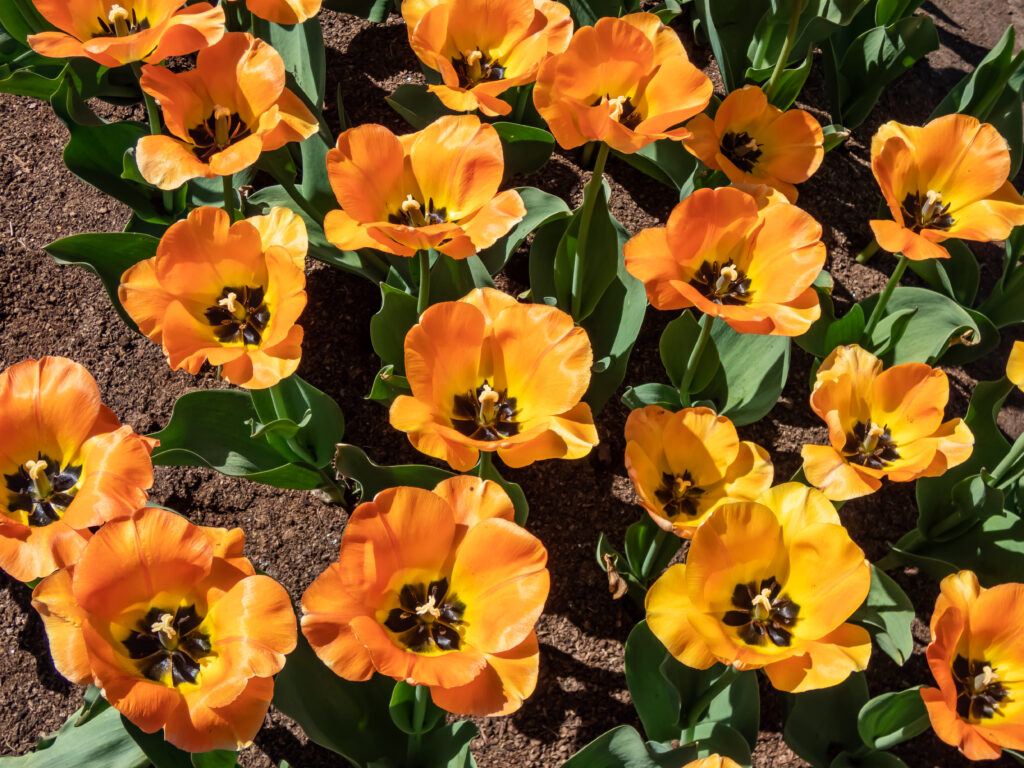
Award-winning, early-blooming Darwin Hybrid Tulip ‘Daydream’ is a captivating beauty with sunny yellow blossoms aging to luminous, apricot to orange as they mature
©iStock.com/Kristine Radkovska
The botanical name for the tulip is Tulipa. They are part of the Liliaceae or lily family and are bulb plants. There are about one hundred species and thousands of cultivars, hybrids, and varieties. The flowers natively grow in Asia and the Middle East and have spread across the planet. They must be grown in climates with cold winters (though not necessarily extreme cold) to reach dormancy and return as perennials.
Snowdrops belong to the genus Galanthus, which make up about 20 species of the flower in the Amaryllidaceae or amaryllis family. Growers cultivate several species, including the common snowdrop (or Galanthus nivalis) and the giant snowdrop (G. elwesii). They grownin the wild and in cultivated gardens for both private and commercial uses. The word “Galanthus” comes from the ancient Greek language, meaning milk flower.
Tulips vs. Snowdrops: Description
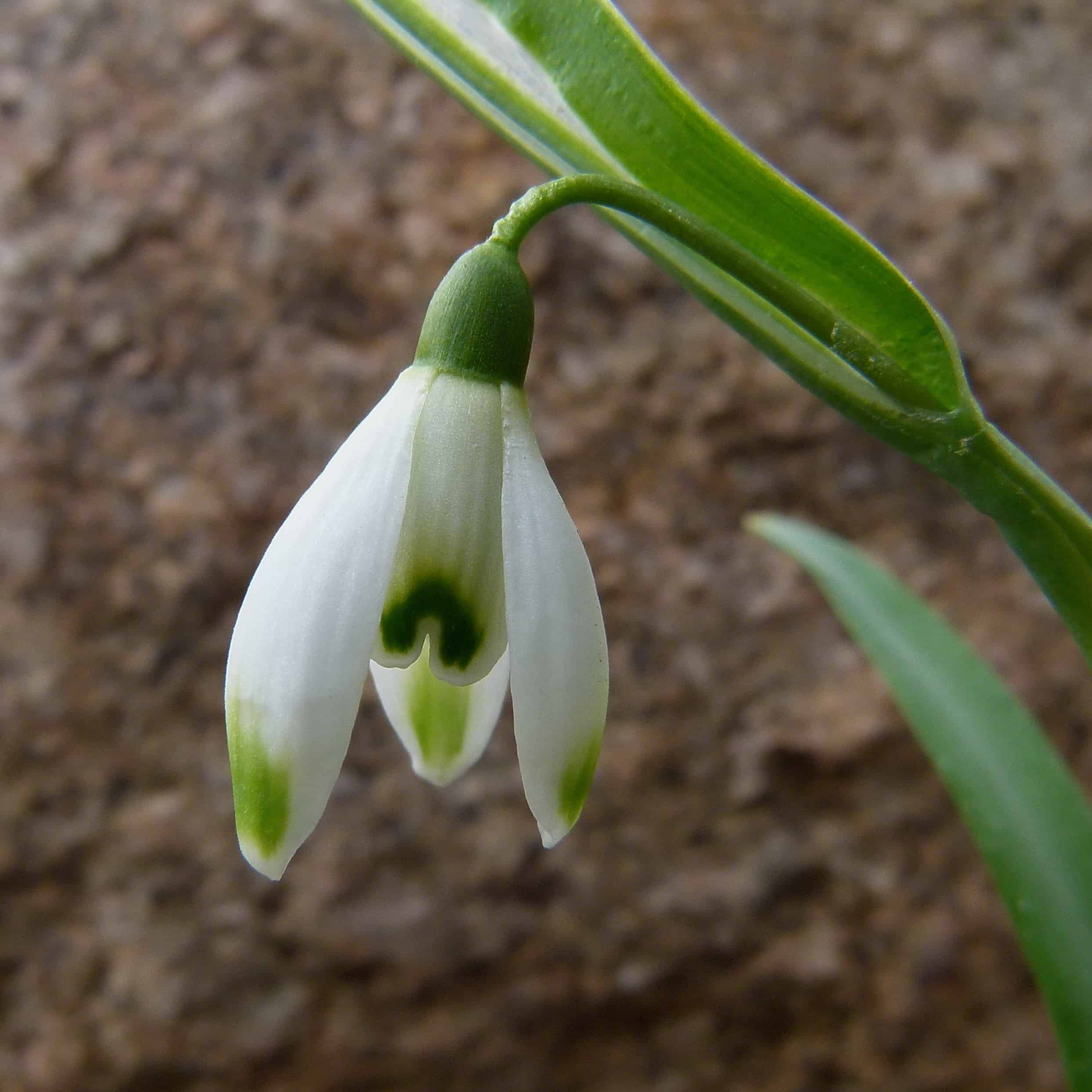
Snowdrops are all white flowers, but some have green accents on them.
©
Growing from bulbs, tulips produce blue-green leaves, usually 2 or 3, clustering at the base of the plant. The flowers are usually bell-shaped. Some are frilled and rigid. They have multiple petals and 3 sepals, and 6 stamens. The flowers come in a huge range of colors, including red, white, purple, almost black, pink, green, cream, peach, tangerine, orange, yellow, lilac, and burgundy. The only color that doesn’t occur in tulips is true blue. Stipres on tulips originated as a virus caused by aphids. Botanists now artificially induce the stripes.
Snowdrops are a white-flowered plant in the amaryllis family. There are several species, including both the common snowdrop and the giant snowdrop. The flowers nod and are often fragrant. They are typically the earliest flowers to bloom each season, often popping up through the snow, in late winter or early spring. The flowers have 6 white petals, often with green tinges. 3 outer tepals are long and curved, with inner tepals small and notched.
Tulips vs. Snowdrops: Uses
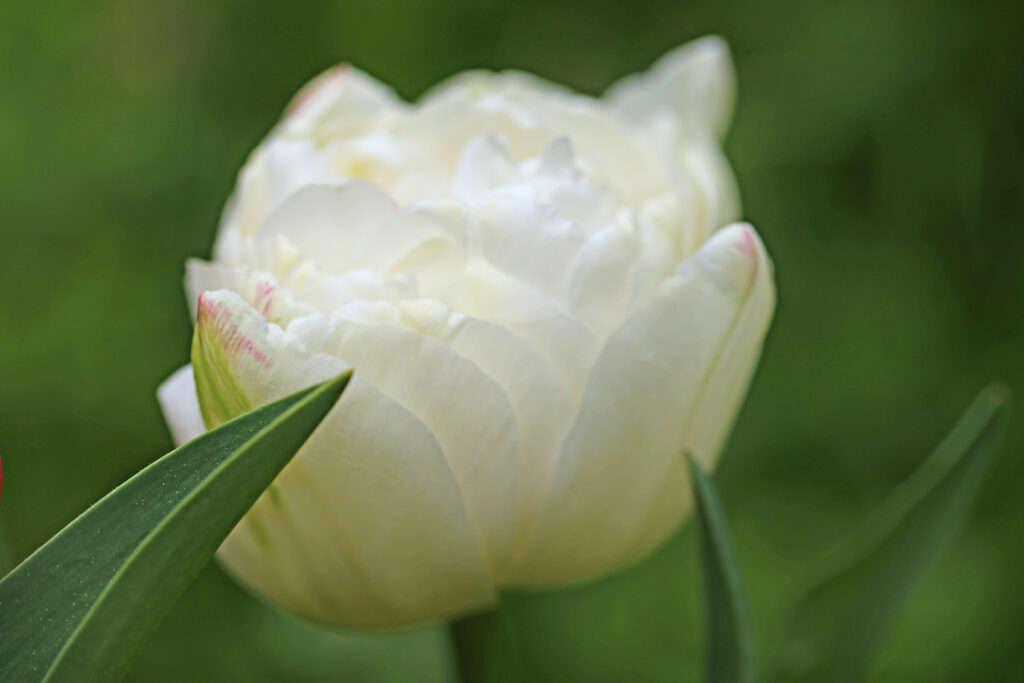
This heirloom tulip is resilient, and its petals are silky yet tough, making it an ideal choice for any garden.
©Yul38885/Shutterstock.com
Tulips
We know tulips for their rich, vibrant colors, ranging from cream and white to the darkest of purples, even almost black. The flowers remain one of the most popular plants in the entire world, ranking third to roses and carnations in the flower category. We use them for floral arrangements, wedding bouquets, potted plant gifts, boutonnieres, and cut flowers as single-stem displays. They are frequent members of container gardens, raised beds, and traditional bed gardens as border plants. The flowers bloom early in a range of colors. You can grow them in bee gardens because pollinators love them.
Tulips are popular for their beauty but they are also edible and have medicinal qualities. You can eat the bulbs and flowers in salads or as onion replacements in the culinary world. Manufacturers use the plant in cosmetics and skincare products. It has healing properties to help calm insect bites, minor wounds and irritations, and dehydrated skin.
Snowdrops
Snowdrops are stunning plants used in ornamental gardens as well. Gardeners sometimes bring them indoors as cut flowers, though less commonly than some other longer-stemmed plants. You can use the flowers as ground cover as well. They also happen to be important to the medical field. They contain the alkaloid galantamine which helps manage symptoms of Alzheimer’s disease. Seventy countries have approved this use. Ancient Greeks, including Homer in his fictional work, The Odyssey, noted its medicinal value. Medical professionals hope that the plant will have further medical uses for treating traumatic injuries to the nervous system and reproductive health and for HIV.
Tulips vs. Snowdrops: Origins and Growing Preferences
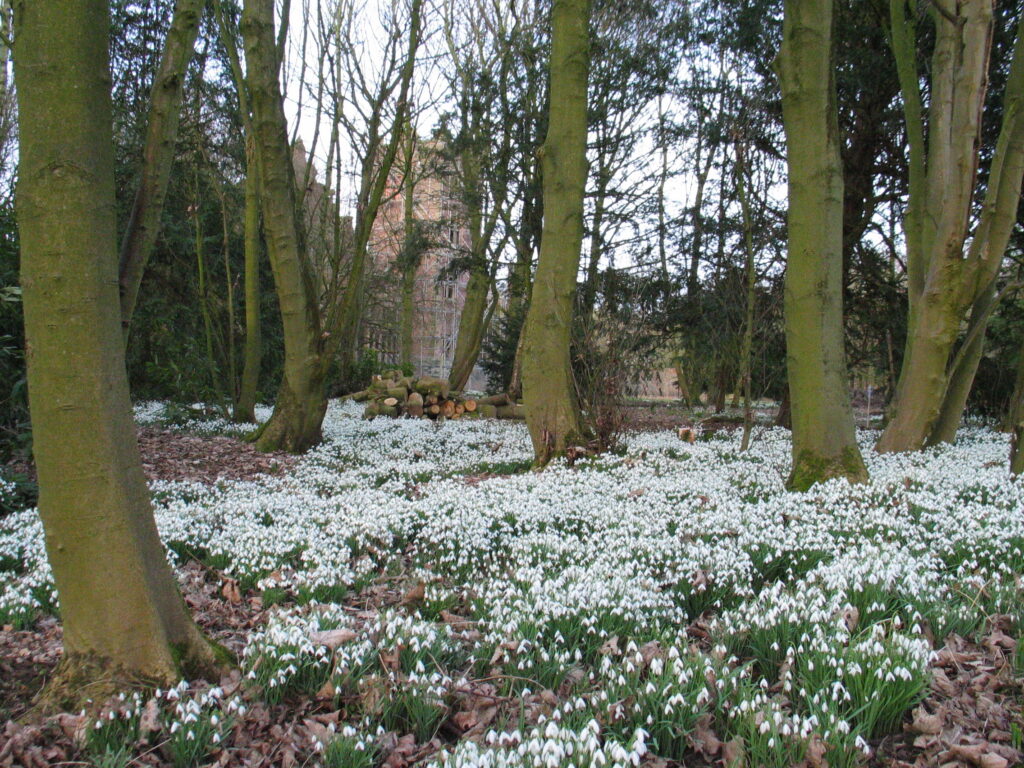
Snowdrops often grow by the thousands in a single location in woodlands.
©Bankhallbretherton / CC BY 3.0 – License
Tulips have been around for millennia, in various parts of Asia and Central America. The first records of cultivated tulips occur in ancient Persia (Iran) in the 10th Century, ultimately becoming the symbol of the Ottoman Empire. Travelers transported the plants to the west where they became wildly popular. The stunning blooms and many uses of the plant continue to keep the plant incredibly popular the world over.
To grow healthy, happy tulips, bury the bulbs with the pointed end up, about 6 to 8 inches deep, 4 to 6 inches apart. They need well-draining soil and full sunlight to thrive. Water the bulbs immediately after planting and keep them moist but never wet or soggy. For perennial tulips, feed them balanced fertilizer when you plant them in the fall.
Snowdrops are native to both the Middle East and Europe. for centureis they have been hugely popular and gifted in parts of Europe where they were exported, particularly the British Isles. Great Britain hosts specialty tours for the flowers naturalized there. They are also popular in other regions of the world, including in Downingtown, Pennsylvania, where a snowdrop festival is held each year, known as the annual Galanthus Gala.
The flowers need partial shade to full sun, with rich humus soil and proper drainage. They do tolerate a wide range of soils, however, and require a cold season so they don’t grow outdoors well in warmer climates. Plant bulbs of snowdrops two to three feet deep in the autumn.
Tulips vs. Snowdrops: Special Features and Fun Facts
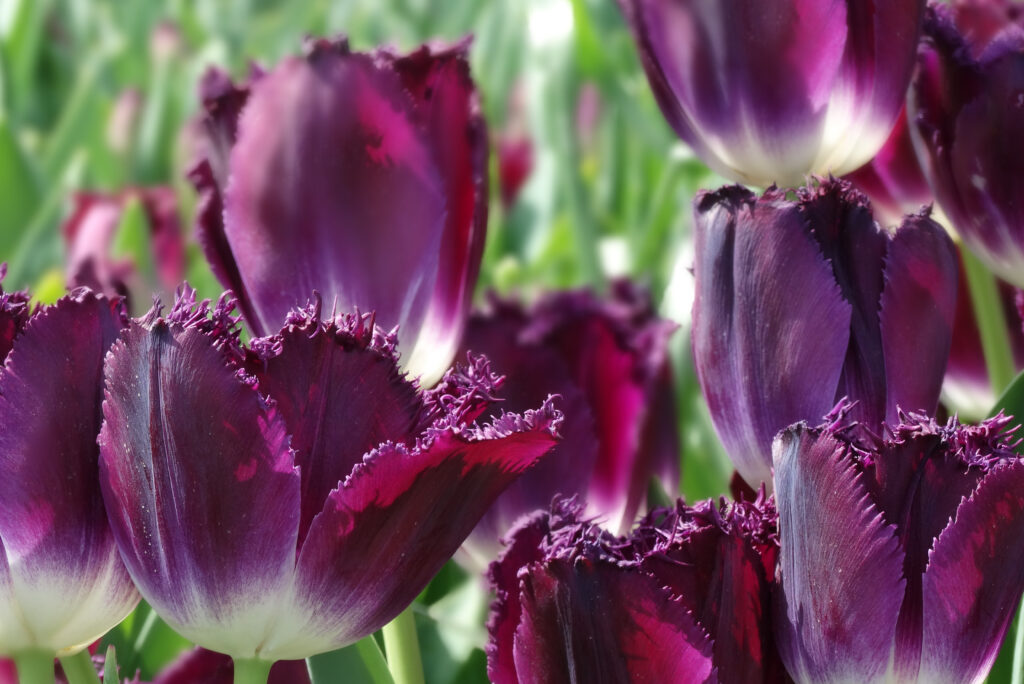
These colorful flowers are great for cutting and attracting butterflies!
©Krystal V.A./Shutterstock.com
Tulips and snowdrops alike are fascinating plants with intriguing histories and symbolism.
Tulips
- Tulips are wildflowers native to central Asia, the Middle East, and along the Chinese-Russian border. The plant spread west across the continents, ultimately taking “over” and becoming the symbol of the Ottoman Empire by 1000 A.D. The tulips surrounded palaces in the gardens then and continue today through Europe and various regions of the world.
- Both snowdrops and tulips have been exceptionally valuable flowers in the world. The value of a single tulip bulb in the 1600s was the price of 10 years’ wages for the common laborer. Snowdrops, on the other hand, continue to be incredibly valuable in some cases, with mutated varieties selling for massive amounts of money. In February 2022, according to Garden Illustrated, a Galanthus plicatus ‘Golden Tears’ plant sold for around $2200. The previous record for a bulb sale was for $1676 for a ‘Golden Fleece’ of the same variety.
- Both Galanthomania (snowdrop craze) and Tulip Mania have resulted in professionals guarding bulbs to prevent theft or destruction.
- Though tulips are first believed to have been cultivated in ancient Persia (Iran), the Netherlands is considered the birthplace of the tulip industry. When the first tulip bulbs were given to botanist Carolus Clusius in the 1500s, he began growing the plants and actually refused to share or sell them. The bulbs were frequently stolen from his bulb garden, however, and the demand for tulips screamed forward. This resulted in not just the Tulip Mania less than a century later, but in the birth of the industry overall as a massive commercial venture.
Snowdrops
- Legend has it that you should never bring a single snowdrop flower into the home, nor the first of the season. This symbolizes a death coming soon. This has given the plant the nicknames of both “death flower” and “corpse in a shroud.” Yet, the snowdrop is a symbol of hope – but only in groupings and never the first one to bloom.
- To this day, Holland remains the largest producer of tulip bulbs the world over. Annually, they export about 3 billion bulbs to the rest of the planet.
- Snowdrops may grow in abundance in many woodlands, but the plants are actually considered endangered and are under threat of extinction in some nations where they natively grow. The reason? Too many have been harvested to sell in the gardening industry. There has been a ban on international trade of the plants since 1995, unless you have a specialized license, to help crack down this over-harvesting issue.
- Every color of tulip carries significance within its shades. Red tulips symbolize love and romance. Yellow tulips mean cheerfulness and joy. White tulips are gifts that say, “I’m sorry.” Purple tulips denote royalty.
- Snowdrops don’t come in a wide range of colors like tulips, but they still symbolize powerful messages. The flower symbolizes spring and new life, hope, new beginnings, rebirth, and the ability to overcome obstacles and challenges.
The photo featured at the top of this post is ©
Thank you for reading! Have some feedback for us? Contact the AZ Animals editorial team.






